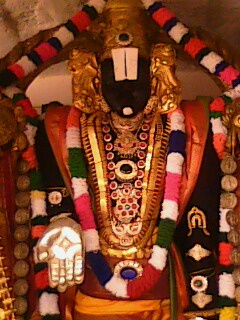Pāñcarātra are the Vaishnava Sanskrit texts dedicated to worship of Narayana and form part of the Agamas.
Unlike Vaikhanasa tradition, the Pancaratric tradition of Agamas prescribe image worship in the place of rituals like Yajnas, mentioned in the Vedas. Agamas cover areas of worship inclusive of construction of the temples; the rules for installation and consecration of the deities; the methods of performing pujas in the temples; philosophy; recitation of mantras; worship involving figures or yantras; bhakti yoga; domestic rituals samskaras; rules of varnasrama-dharma and public festivals. Various Vaishnava traditions have different degree of adherence and various lists of texts included under the overall concept.
Vishnu worshipers of today, represented in a wide spectrum of traditions, are generally following the system of Pancaratra worship. The concept of Nada and Nada-Brahman appear already in Sattvata Samhita or Sattvata Tantra and in Jayakhya Samhita, two texts considered most canonical of Pancaratra texts.
Ananda Tirtha the founder of Madhva line has written in his commentary on Mundaka Upanishad: [1] "In Dvapara-yuga, Vishnu is exclusively worshiped according to the principles of the Pancaratra Scripture, but in this age of Kali-yuga, the Supreme Lord Hari is worshiped only by the chanting of his Holy Name."
Jiva Gosvami had stated in his Paramatma Sandarbha, forming part of six principal Sandarbhas, or philosophical treateses of Gaudiya Vaishnavism, that, "Seeing that the imperfect scriptures in the modes of passion and ignorance bring only a host of troubles, and also seeing that the original Vedas are very difficult to follow properly, and thus being very dissatisfied with both of these, the all-knowing scripture authors affirm the superiority of the Pancaratras, which describe the pure absolute truth, Narayana, and the worship of the Lord, which is very easy to perform."[2] In the same Sandarbha Jiva Gosvami states[3] that god himself,Svayam Bhagavan, had spoken the Narada Pancaratra, which is accepted as a pramana byGaudiya scholars.
Six aspects of surrender in the Pāñcharātra
Surrender to god is one of the core teachings of Pancharatra. The six aspects are explained below in brief:
i) Atma-nikshepa or nyAsa - placing oneself completely and directly under God's care. This involves giving up independent ownership in matters of actions or fruits thereof. This in fact is the real SaraNAgati. The subsequent five are to be regarding as assisting this. The obstacle to nyAsa is phalepsA or the desire for mundane benefits,which should therefore be avoided.
ii) kArpaNya - This refers to absolute humility bordering on lowliness and honest awareness of one's own natural ignorance, impurity etc., partly because of stains acquired through countless births. We all know the enormous feeling of kArpaNya that our AzhvArs have expressed through their compositions. This leads to ridding the arrogance that one may have because of parentage, learning, wealth, etc., and to get the sense that without the aid of Godhead, whatever we undertake on our own is bound to fail. The enemy for kArpaNya is the feeling that one is free, independent,and competent to do whatever he likes (sva-svAtantryAvabodha).
iii) mahA-viSvAsa - irrepressible and great faith in Godhead. Involves the understanding that God is the benefactor of all beings, and His compassion is always and readily available. The firm conviction that He will not fail to protect us is 'viSvAsa'. This by itself is capable of eradicating all sins.
iv) goptR - The deliberate choice of bhagavAn SrIman nArAyaNa as the sole Protector. Even when it is granted that anyway He is the sole protector, lakshmI-tantra points out that what is involved in this a'nga is the conscious and mindful selection of Him, the acknowledgment that we need protection, and that He and only He can protect us.
v) prAtikUlya-vivarjana - giving up whatever is antagonistic to any of His creations or to Him. A devotee must realize that all beings are like himself.
vi) AnukUlya-niScaya - The resolve to do good to all beings. The realization that all beings are in actuality the body of God, and the resolve to live in accordance with the will of God. Ahirbudhnya samhitA gives a beautiful illustration of SaraNAgati using a passenger who wants to cross a river in a boat. It is the passenger's responsibility to go and sit in the boat, and that is the end of his responsibility; the job or rowing the boat is not his, but that of the boatman (in this case God Himself).
Six aspects of surrender are described in many PancarAtra samhitas such as Ahirbudhnya Samhita, Lakshmi Tantra etc., thought the order of importance may vary. Lakshmi Tantra give the following:
"AnukUlyasya samkalpah prAtikUlyasya varjanam |
rakshishyatIti viSvAso goptRtva varaNam tathA ||
AtmA nikshepa kArpaNye shadvidhA SaraNagatih || (Lakshmi Tantra 17, 59-61)
Thus the order of the limbs given in Lakshmi Tantra is: Anukūlya Samkalpam, Prātikūlya Varjanam, Mahā Viṣvāsam, Goptṛtva VaraNam, Atma Nikshepam, and kArpaNyam. In Ahribudhnya Samhitā, the order given is: Atma Nikshepam or Nyāsam, KārpaNyam, Mahā Viṣvāsam, Goptṛtvam, Prātikūlya Varjanam, and Anukūlya Sampakpam. Svāmi Deṣikan has addressed these confusions in his Nyāsa VimSati (Slokam 12), and concludes that those who know Prapatti Sāstra well agree that there are five anga-s to Prapatti, and the different positions taken in respect of the number and sequence of importance etc. of the aspects of Prapatti really say the same thing in the end (sarva vākya eka kaNThyam).
Atma Nikshepam or nyāsam is considered the main ingredient of Prapatti - the conviction that one's own effort in attaining Him will not bear fruit, and placing oneself directly under His care and giving up ownership of one's own protection or the benefits from any actions to Him. The other five are then the limbs for Nyāsa, that are of equal importance as conveyed to us by Svāmi Deṣikan. Thus, for performing surrender or Atma Nikshepa or Nyāsam, one needs absolute humility (KārpaNyam), Anukūlya Samkaplam, Prātikūlya Varjanam, etc.













































